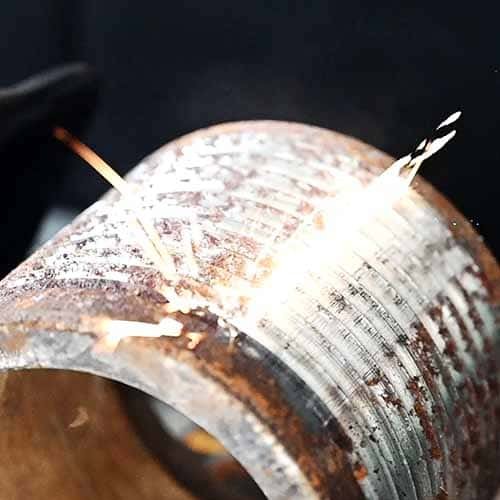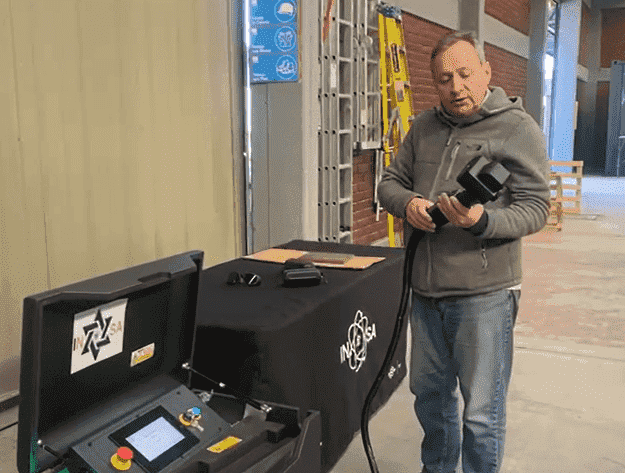
Traditional cleaning methods such as sandblasting, chemical stripping, and abrasive blasting can be time-consuming, labor-intensive, and often damage the material surface. In industries like manufacturing, aerospace, and automotive, where precision and efficiency are key, these methods often fall short.
Agitate: These outdated methods can result in excessive waste, toxic chemicals, surface wear, and costly rework. As industries push for better efficiency and eco-friendly solutions, finding an alternative is crucial.
Solution: Laser cleaning technology offers a cutting-edge solution, enabling industrial professionals to clean parts with precision, efficiency, and eco-friendliness. Laser cleaning uses advanced laser beams to eliminate contaminants like rust, paint, and oxidation, all while preserving the underlying material and reducing environmental impact.
How Do Laser Cleaners Work?
Laser cleaning is an advanced surface preparation technique that uses a highly focused laser beam to remove contaminants such as rust, dirt, paint, or other coatings from a surface. The laser energy is absorbed by the contaminants, causing them to vaporize into dust and fumes, which are then safely removed from the surface.
Key Steps in the Laser Cleaning Process:
- Laser Emission: A laser beam, typically from a fiber laser or CO2 laser, is directed onto the surface of the material. The laser pulse length, power, and intensity are precisely controlled to ensure optimal cleaning.
- Ablation of Contaminants: As the laser energy interacts with the surface, it heats the contaminants to a high temperature, causing them to vaporize into particles and gases.
- Removal of Contaminants: The vaporized particles are then ejected from the surface by the force of the laser beam or through additional airflows, leaving behind a clean, contaminant-free surface.
- Surface Preservation: Importantly, the laser cleaning process does not damage the substrate material underneath. Unlike abrasive techniques, which can wear down the surface, laser cleaning is precise, gentle, and effective.
This process is efficient and can be used for a wide range of applications, from rust removal on metal surfaces to cleaning delicate components like turbines and molds in manufacturing.

What Are the Disadvantages of Laser Cleaning?
While laser cleaning offers many benefits, it’s important to understand its potential limitations and challenges:
- High Initial Cost: The initial investment in a laser cleaning system can be substantial, especially when compared to traditional methods like sandblasting. However, the long-term savings in labor, efficiency, and quality often outweigh the initial expense.
- Technical Complexity: Laser cleaning requires specialized knowledge to operate effectively. Operators must understand the system’s settings and parameters, such as laser power and pulse frequency, to ensure optimal results.
- Material Limitations: Not all materials respond well to laser cleaning. Very hard or reflective materials, such as certain types of ceramics or metals, might require special settings or may not be ideal for this method.
- Energy Consumption: While laser cleaning is more efficient than many traditional methods, it can still consume a significant amount of energy, especially when cleaning large surfaces or heavy contaminants.
- Slower Process for Large Areas: Laser cleaning can be slower for large surface areas compared to other methods, especially if high precision is required. This can limit its use in some large-scale operations.
Despite these challenges, the growing adoption of laser cleaning technology demonstrates its effectiveness, especially in applications where precision and eco-friendliness are top priorities.
Do Laser Rust Removers Really Work?
Yes, laser rust removal is highly effective. One of the most common uses of laser cleaning is the removal of rust and other oxidation from metal surfaces. The process works by targeting the rust with focused laser beams that vaporize the rust particles without affecting the underlying metal.
- Efficiency: Laser cleaning removes rust quickly and efficiently. It does not require any harsh chemicals or abrasives, which can damage the metal surface or create waste products.
- Precision: Since the laser beam can be finely tuned, laser cleaning is ideal for delicate or intricate parts that require precision. For example, it can be used to clean parts like machinery, automotive components, or even historical artifacts without risking surface damage.
- Eco-Friendly: Unlike traditional rust removal methods, laser cleaning is eco-friendly. It doesn’t involve the use of toxic chemicals or abrasive materials, making it a safer, more sustainable option for many industries.
Laser rust removal is particularly beneficial for industries such as automotive manufacturing, aerospace, and even the restoration of metal sculptures or historical monuments, where preserving the integrity of the material is critical.
Is Laser Cleaning Effective?
Yes, laser cleaning is incredibly effective for a wide range of materials, contaminants, and industrial applications. Whether you’re removing paint from metal surfaces, cleaning rust off industrial machinery, or preparing parts for coating or welding, laser cleaning is versatile, efficient, and precise.
- Surface Preparation: In many industries, laser cleaning is used as a pre-treatment step before coating or welding. The laser removes contaminants and oxide layers, ensuring that the surface is clean and ready for the next process, resulting in better adhesion and fewer defects.
- Restoration: For industries involved in the restoration of machinery, historical artifacts, or even sculptures, laser cleaning offers a gentle but effective way to clean delicate surfaces without causing damage. Laser technology allows professionals to work on complex surfaces that would be difficult to clean using traditional abrasive methods.
- Cost Efficiency: Although the initial setup cost is higher, laser cleaning provides long-term savings. It reduces downtime, minimizes the need for hazardous chemicals, and is faster than many traditional methods, resulting in increased productivity.
In sectors like aerospace and automotive, where precision and surface integrity are crucial, laser cleaning has proven to be an invaluable tool.
| Thickness (um) | 100W | 200W | 300W | 500W | 1000W |
| 20 | 4 | 8 | 12 | 20 | 30 |
| 50 | 1.5 | 3 | 5 | 9 | 15 |
| 100 | 1 | 2 | 3 | 5 | 10 |
| 150 | 0.8 | 1.5 | 2 | 4 | 8 |
| 200 | 0.5 | 0.8 | 1.5 | 3 | 5 |
| 250 | 0.4 | 0.7 | 1 | 2 | 4 |
Does Laser Stripping Really Work?
Laser stripping is an effective method for removing paints, coatings, and other surface layers. Laser ablation can precisely strip layers from a surface without damaging the underlying material.
- Precision: Laser stripping offers a highly controlled method for removing coatings without causing damage to the substrate. This is ideal for delicate parts, like metal molds or historical pieces, where precision is key.
- Efficiency: Laser stripping is faster and more efficient compared to traditional methods like sandblasting or manual scraping, which can be slow and imprecise.
- Eco-Friendly: As with other laser cleaning applications, laser stripping doesn’t produce harmful waste or use toxic chemicals, making it a safer and more sustainable choice for many industries.
Laser stripping is commonly used in industries like automotive, aerospace, and metalworking, where removing paint or coatings is necessary without compromising the integrity of the material.
Laser Cleaning vs. Sandblasting: Which is Better?
When comparing laser cleaning to sandblasting, several key differences stand out:
- Precision: Laser cleaning is more precise than sandblasting. While sandblasting can result in surface wear and may be too aggressive for delicate parts, laser cleaning can be finely controlled to remove contaminants without damaging the substrate.
- Efficiency: Laser cleaning is generally faster than sandblasting, especially for smaller or more intricate parts. Additionally, it requires less preparation and cleanup.
- Environmental Impact: Sandblasting often involves abrasive materials and chemicals that can harm the environment. In contrast, laser cleaning is a cleaner, more sustainable option, with no need for consumable materials or hazardous chemicals.
- Surface Preservation: Laser cleaning leaves the surface undamaged, which is particularly important when working with valuable or sensitive materials, such as historical artifacts or precision components.
For most industrial applications, laser cleaning is the superior choice due to its precision, eco-friendliness, and ability to preserve material integrity.

What Are the Main Applications of Laser Cleaning in Industry?
Laser cleaning is used in a wide range of industrial applications, including:
- Rust Removal: As discussed, laser cleaning is highly effective for removing rust and corrosion from metal surfaces, making it ideal for industries like automotive manufacturing, shipbuilding, and aerospace.
- Surface Preparation: Laser cleaning is often used as a pre-treatment step before coating or welding, ensuring that surfaces are clean and free of contaminants.
- Paint Removal: Laser stripping is a common use for laser cleaning, particularly in automotive, aerospace, and heritage restoration industries.
- Restoration: Laser cleaning is used for cleaning historical artifacts, sculptures, and other delicate materials, providing a gentle yet effective cleaning solution.
- For more basic knowledge of laser cleaning, click here.
Laser Cleaning Machines: What Are the Costs?
The cost of laser cleaning machines can vary depending on factors such as the size, power, and features of the system. While the upfront cost can be high—ranging from a few thousand to several hundred thousand dollars for industrial models—the benefits of efficiency, precision, and sustainability often make laser cleaning a wise investment in the long run.
For industrial professionals looking for high-quality, reliable laser cleaning machines, Chihalo Laser offers a range of products designed for diverse applications, from rust removal to paint stripping.
Summary
Laser cleaning technology is transforming industries that rely on precision, efficiency, and eco-friendly solutions. While it may come with a higher initial investment, its long-term benefits far outweigh the costs, providing an effective solution for removing contaminants like rust and paint without damaging the substrate. For professionals looking to streamline their cleaning processes and adopt cutting-edge technology, laser cleaning is the way forward.
For more information on laser cleaning solutions, including high-performance models for industrial applications, check out Chihalo Laser.
